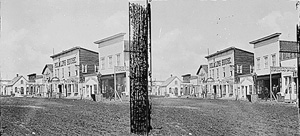CHEYENNE, WYOMING

A stereograph of Cheyenne, Wyoming, 1869
View largerCheyenne, the capital city of Wyoming, is located in Laramie County on the semiarid High Plains at an elevation of 6,100 feet. In 2000 the city's population was 53,000. The Union Pacific Railroad gave birth to Cheyenne during the summer of 1867 when its chief engineer, Maj. Gen. Grenville M. Dodge, selected and surveyed the site as a supply depot. The city was named for the Cheyenne Indians, who ranged in the area and had engaged in hostilities with Dodge. The name Cheyenne is probably a Lakota term meaning "people of different speech" or "red talkers." The town literally sprang into existence, engulfed by numerous barkeeps, gamblers, merchants, and prostitutes who inhabited the "Hell on Wheels" communities that traveled with the construction gangs of the railroad. By November 13, 1867, when the first train arrived, Cheyenne's population had grown rapidly to 4,000. At first, the city was part of the Dakota Territory, but in 1869 Cheyenne was selected as the territorial capital of the newly established Wyoming Territory. A few miles northwest of the city the army built Fort D. A. Russell and Camp Carlin, a major quartermaster supply depot.
In 1875, with the discovery of gold in the Black Hills, Cheyenne became an outfitting center for miners and stage passengers on their journey to the mines. The railroad was also essential in the development of the prosperous Wyoming livestock industry, and Cheyenne became the center of the territory's cattle boom. Wealthy ranchers built luxurious homes in a neighborhood dubbed Millionaires' Row and mingled at the elegant Cheyenne Club. Because of its rapid birth and ability to recover from periodic economic slumps, Cheyenne was called the "Magic City of the Plains." As the city matured during the territorial period (1869–90), it also developed a reputation as a social and cultural center. The city was notable for its opera house, the Atlas Theater, the Cheyenne Club, the Inter-Ocean Hotel, numerous retail businesses, and more than forty lavish mansions. The success and wealth of the city attracted western legends such as Wild Bill Hickok, Calamity Jane, Buffalo Bill Cody, Tom Horn, and Wyatt Earp, who rode shotgun on the Cheyenne–Black Hills stage.
Historically, government has been an important economic base of Cheyenne, especially after the creation of the state of Wyoming in 1890. Among the city's prominent politicians and judges have been Joseph M. Carey, U.S. attorney for the territory of Wyoming, justice of the Wyoming Supreme Court, territorial delegate to Congress, U.S. senator, and Wyoming governor; Willis Van Devanter, who held the positions of chief of the territorial court and federal court justice and was appointed to the U.S. Supreme Court in 1910; and Francis E. Warren, a rival to Joseph Carey who was perhaps Cheyenne's most distinguished citizen. He served as territorial governor, first governor of the state of Wyoming, and U.S. senator for thirty-seven years.
Transportation has always been an important economic and cultural stimulus for Cheyenne. For years Cheyenne was a repair terminal and passenger depot for the Union Pacific. As the railroad's impact on the community subsided, Cheyenne benefited from its location along the Lincoln Highway, the nation's first coast-to-coast automobile thoroughfare, and today the city has the advantage of being at the junction of Interstates 80 and 25. Its economic base still includes agriculture, cattle, sheep, and the railroad, but its major economic benefits derive from the presence of federal and state governments and Warren Air Force Base. Cheyenne's most important tourist attraction is the Frontier Days rodeo, popularly known as the "Daddy of 'Em All." Regarded as one of the largest and oldest continuous rodeos in the country, Frontier Days held its first Wild West celebration on September 23, 1897.
See also POLITICS AND GOVERNMENT: Warren, Francis / SPORTS AND RECREATION: Rodeo / TRANSPORTATION: Dodge, Grenville.
Mark Elliott Jim Johns Laramie County Community College
Adams, Judith. Cheyenne: City of Blue Sky. Northridge CA: Windsor Publications, 1988.
Carley, Maurice, William Dubois, and Katherine Halverson. Cheyenne: The Magic City of the Plains. Cheyenne WY: Cheyenne Centennial Committee, 1967.
Field, Sharon Lass, ed. History of Cheyenne, Wyoming. Dallas: Curtis Media Corporation, 1989.
Previous: Cattle Towns | Contents | Next: College Towns
XML: egp.ct.012.xml
